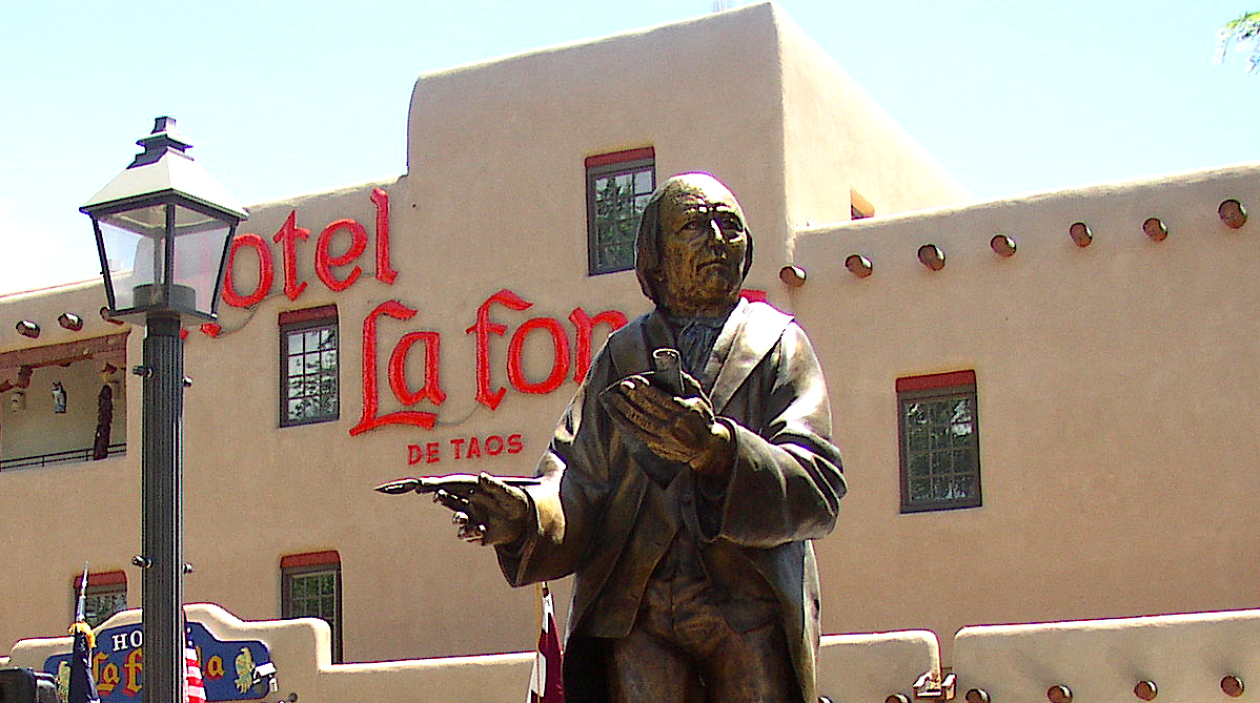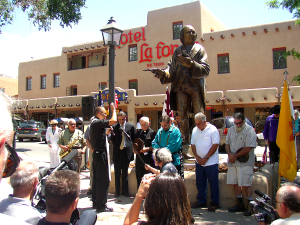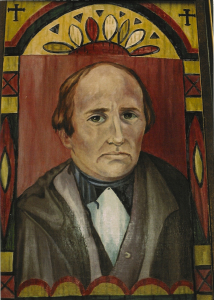INTRODUCTION
Cecil V. Romero, a relative of Padre Martínez, in 1928—ninety years after Padre Martínez published his autobiography on his own press (Los Méritos del Presbítero Antonio José Martínez, Cura de Taos)–translated it into English for the NM Historical Review. With an eye on that previous translation, Father Tom Steele, S.J. this shorter version of this autobiography from a copy of the original that Padre Martínez wrote in 1840, and presented to his ecclesiastical superiors in Durango.
On October 21, 2009, Father Steele–with help from Vicente Martinez, Robert Torrez and myself–finished the translation. Father Tom was pleased with my editing the biography into final form. It was intended to be the first part of a three-part scholarly work in English complemented with other key primary documents: the 1877 Biography of Padre Martínez by Santiago Valdez (for which I was principal agent), and the Padre’s Last Will and Testament (for which Vicente Martinez of Taos, closely related to the Padre, was principal agent). Padre Martínez edited his Will within a month before he died in July 1867.
Elena Nápoles Goldfeder, a Cuban American with a doctorate in Spanish literature, greatly helped in the translation of various works pertaining to the Cura de Taos, including his 1840 autobiography. Father Steele was to be editor of the total project of the TRILOGY, but when his health began to fail, he asked his former student Robert Torrez–former historian for the state of NM–to continue in the role of editor.
The 1840 abbreviated autobiography presented to his superiors in Durango during his year of sabbatical–as well as his original 1837 autobiography under the title Méritos del Presbítero Antonio José Martínez, Cura de Taos (published on his press in 1838)– is incomplete on several accounts.
• Padre Martínez does not mention his legitimate wife who died in childbirth before he went to the seminary.
• Neither does it make reference to his housekeeper by whom he also had children.
• Since the autobiography was edited and completed by 1840, it necessarily does not deal with the Padre’s contentious relationship with his Bishop Jean Baptiste Lamy who arrived in New Mexico in 1851, five years after it became part of the United States.
However, the autobiography does clarify many aspects and details of the life of the Padre heretofore unknown or misunderstood.
In a letter to Vicente Martínez, Father Steel gave his imprimatur–expressing his approval of the final touches I gave to our collective translation of the 1840 Autobiography of the Padre. In homage to Jesuit priest Father Thomas Steele, a superior scholar on things New Mexican, a mentor and collaborator, I publish this work on my website, The Taos Connection, on March 25, 2015, the feast of the Annunciation.
Padre Martinez of Taos: His Life and Times
SECTION ONE: 1840 AUTOBIOGRAPHY
ACCOUNT OF
The Literary, Ecclesiastical, and other Services in the Career of
The Priest
Don Antonio Jose Martinez y Santistevan, Interim Curate of Taos in the Department of New Mexico
He states that he is a Mexican by nationality born in this Department of New Mexico, and in the parish of Santo Tomas de Abiquiú. The late Don Antonio Severino Martínez and Doña María del Carmen Santistevan, husband and wife in legitimate and unbroken matrimony, of good blood, also Mexicans, were his parents. He was born on January 17, 1793, and was baptized on the nineteenth of the same month, as shown in his baptismal certificate in the chancery office. In the attached book composed of documents, this document [missing baptism certificate to be obtained] is marked (as Document #1) on a blank page in expectation of the certified record turning up. [004 – These enumerations in brackets refer to the page numbers in the original document or copy thereof.]
He is now in his forty-eighth year. On March 10, 1817 when he was in his twenty-fifth year, he began his studies in the Tridentine Seminary of Durango as a boarding student, beginning from the study of Latin grammar, until March 9, 1820. On that day, he was granted gratis a Royal Scholarship in preference to others (see Document #2). He enjoyed the benefice until January 1823 when, with his superiors’ permission, he left the school and returned to this Departamento and to the home of his parents. The total time of his studies in the college was five years, ten months, and a few days.
During his time, he studied Latin grammar and Spanish rhetoric, and in these subjects he held first place among all the rest of his fellow students. (See Document #3) In compliance of the request of Bishop Castañiza, he lodged with him. A particular certificate of equal value to First Place in (Spanish) Rhetoric, since that served as the foundation for advancement of someone who had studied all grammar courses, would have been a certificate for the study and mastery of Latin grammar. However, that remained in the file of one of his petitions for Holy Orders at the diocesan office. He studied philosophy [005] beginning with four questions about Certitude, Logic, Ontology, and the Metaphysics of Reality from its author the Abbe [Francois] Para [du Phanjas]. Father Altieri’s books covered Arithmetic, Algebra, Geometry, and General Physics. At the end of the course, he was given the Supralocus, recognition of first place above all of his fellow students (as attested by Document #4).
In the manual of Scholastic Theology of His Eminence Cardinal Gotti which he studied for only two years, he presented more options than requirements demanded of him. All in all, he received the very highest grade with a superior note of distinction (As shown by Documents ##5 and 6). [006]
Finally, in the College, he studied the whole manual of Moral Theology, fourth edition, by the author Francisco Larraga, with examples by Grosin; he also studied The Sacred Ceremonies by the rubricist Galindo, supplementing his understanding by reading other authors. No professor explained these last two subjects because he studied them privately while taking the regular scholastic course. The first time around when he was a student in Durango, he earned certificates of the highest standing from the examinations that he underwent; according to the original certificates given him, he passed the courses for the exercise of the ministry with complete comprehension. Besides completing his studies and making a very detailed and thorough review of everything that he completed in school, he finally completed–at the house of his parents that was also his own–the author Gotti’s Scholastic Theology from his forty treatises in its three tomes as well as Murillo Velarde’s Scholastic-Dogmatic Theology from its hundreds of treatises contained in the ponderous tomes.
Almost as soon as he had begun college, in preference to any other of his classmates, he was made responsible for keeping [014] the classrooms in order, and he also took turns teaching in his respective classes. In 1819, the Rector placed him in charge of the expenses for kitchen and costs for repair of schoolrooms. He took care of the brickwork and the whitewashing, mending the stairs and fixing the doors, and he was also responsible for the younger boys’ clothing, keeping them in order and seeing that they attended the ceremonies at the Cathedral. In regards to housekeeping, he held the keys to the pantry and avoided abuses; he secured the back or side gate when the shepherd took the sheep out each dawn and brought them back each evening.
In the year 1821, he took care of all his schoolmates in the college and became the sub-minister. He discharged this duty to the complete satisfaction of his superiors, along with the others noted above until January 1823. He then gathered these certificates and various others, and left the college. (As shown in Document #6 mentioned above) [015] Regarding the evidence of Document #7, in 1822 he had the choice of saying the weekday Masses [taking turns with] with the priest-professors in the College, or of being the Chaplain to the College with the faculty [license/permission] of hearing Confessions on Saturdays for those who had to obey that precept and receive Communion. He also participated in the care of the Sagrario of the Parish, but unfortunately, he failed to obtain a certificate.
The Most Reverend Bishop, His Excellency Don Juan Francisco de Castañiza ordained him to all [the four] minor orders at the same time on March 16, 1821, and to the Subdiaconate on the following day. The Bishop ordained him to the Diaconate on December 22, 1821, and later to the Priesthood on February 10, 1822. (Document #10) All these ordinations followed proper examinations and approval of his abilities, and with dispensations from [observing] the required intervals. His First Sung Mass was on February 19, 1822. At the [other] ordinations that followed [almost four months later] on June 1, 1822, he received for the first time quite comprehensive faculties [license] for preaching and hearing Confessions. [016]. In addition to required theological courses–all of Moral Theology and Liturgy [mostly rubrics]–he studied additional optional courses in theology, as they appear in the licentiate diplomas and the abovementioned documents. His faculties were later expanded to authorize his celebrating two Masses on feast days, absolving from reserved sins, marrying and validating marriages intra confessionem, giving blessings in which Holy Oil is not used, and applying a plenary indulgence to dying persons. All [the faculties–that the Bishop or the legislative Council—wills] were granted for whatsoever period. The first time this authority [of extended faculties] was given to him was on January 18, 1826, when it came about by recommendation of the venerable Ecclesiastical Council that wrote him as follows: “Because of the great praise and recognition you deserve, the Venerable Council instructs me that I should declare your merits in writing, and thus they appear in Document #8. In the same manner, the faculties [licenses] obtained from the present Bishop the Most Reverend Don José Antonio Laureano de Zubiría, during his Holy Visitation of July 6, 1833, have continued to be completely valid.” [017]
He left college one year short of finishing his course in Scholastic Theology because he fell sick of an ailment that impeded his breathing. When he had recovered from it at his parents’ home, he asked for time to exercise his ministry. He was granted this as shown in Document #9. Concerning his services in this period, he said Mass, preached, heard Confessions, and attended to the sick while he being very faithful and prompt in charity as need and situation required. His sound conduct in religion and among the town’s society appears in Documents ##10 and 11 that originate from the Town Council of Taos. Document #12 comes from the Alcalde of Tomé, where he helped in priestly ministry from November 24, 1823 to March 20, 1824 (AHAD 253f088). He had the approval of the [018] Chancellor of the Diocese, as seen in Document #13, since he himself had especially recommended his taking that post.
In 1826, he took over the administration of Santo Tomas de Abiquiú parish, as is attested in Document #14. He most carefully served the parish as regards the administration of the Holy Sacraments, preaching on the Gospel on feast days, conducting himself among the faithful of the parish and among the authorities with the greatest harmony, affection, and proper manners—aiding the poor with alms, and not burdening the poor with the aranceles if he found that he could get along without them. He continued until September of that year [1826] when he resigned from that parish as shown by Document #15. His resignation [from Abiquiú] came about because he was at that time [also] serving the parish of Taos that Vicar [Fernandez San Vicente], mentioned above, had put into his care (by virtue of Document #16) from July 23, 1826 to the present [1840]. Vicar Fernandez San Vicente visited the parishes in the year 1826 [019], as well as the chapels of Taos and Abiquiú during August. In August 1830 [four years later], Vicar Don Juan Rafael Rascon visited the [Pueblo] Parish and the Chapel of [Fernando de] Taos [i.e., Our Lady of Guadalupe]. In July 1833, the present Bishop, the Most Reverend Don José Antonio Laureano de Zubiría, visited the same parish and its chapels. He approved of his fulfillment of ministry in all the matrimonial diligencias [Pre-Marriage Investigations], and of the decisions copied into the entries of all the (parish) books— all comparing quite favorably with the fulfillment of ministry by his predecessors, and even comparing with other parishes that he [Bishop Laureano Zubiría] had visited. In checking entries in those books, each (reverend) visitor specifically stated in very particular terms that he [the parish visitor] congratulated him [Padre Martinez] and encouraged him to continue in the same manner, as attested by Document #17, a certification of the entries on the occasion of a Holy Visitation as stated above. Together with the Parish of Taos, he has also managed the mission of San Lorenzo de Picuris first by order of Vicar Don Juan Rafael Rascón from March 1829 to April 1831. Then he resigned for [020] adequate cause, and the resignation was accepted as stated in Document #18. He managed the mission of San Lorenzo de Picuris for a second time from November, or more precisely from October 25 1833, until the present. He has held all of these duties as Acting Pastor by order of the present Bishop as indicated in Document #19, and has fulfilled all of them as best he could. He learned that being unable to attend the competition [in order to be considered for an appointment as pastor] did not lower his reputation insofar as the secretary of the Church [Diocesan] Council [021] makes clear as shown on this point by Document #20.
He has served in the places and times mentioned above, and has faithfully performed the duties of his ministry. He has several times led Holy Week Stations [of the Cross] in Taos and Santa Fe, has said Mass on two feast days and even preached in both, but always [at least] in one. He says Mass at times in the church of Abiquiú or the church of Picuris, and then in the church of Our Lady of Guadalupe in Taos as much as seven leagues [eighteen miles] distant. Documents where he has served in other places have proved what his duties were, as also do Documents ##21, 22, and 23. The last two documents mention that his conduct was always upright in religious matters and in polite society. He has donated to the church, and distributed seed annually to needy persons. [022]
He has been, and still is, delegated as the minister of the Tertiaries of Saint Francis of the Order of Penance [Penitentes] among the devout parishioners of Taos, as attested by Document #24 of the Father Custodian.
From 1833 to the present, he has had the delegation of administering Confirmation in this parish [of Taos] and in the mission of Picuris, a faculty he has exercised as shown by the certified entries in the proper parish register, and Document #25 states his authority of confirming and functioning as [but not yet officially appointed as] the Pastor of Taos.
In politics, he has been elected first to the office of Territorial Deputy, a post that he discharged in the Capital of Santa Fe during 1830 and 1831, and [023] he has attended the Departmental [legislative] Council as Deputy whenever it met up until the present, contributing toward the expense of paying for a secretary. He has also contributed a certain amount of money to the services of the state that the Honorable Deputy Vicar Don Juan Felipe Ortiz assigned to him for travel expenses, and he has contributed another equal amount for the Texan emergencies as shown in Documents #26 and #27 given him by the same Vicar Ortiz.
He contributed for the relief of the troops used in quelling public disorder in this Departamento last year as Document #28 attests. Lieutenant Don José Silva gave him a receipt, and there were small amounts he refrains from mentioning. During the disorderly uprisings of last year [1837?] and even as this statement is being written [Padre Martinez seems to be quoting from his original autobiography written in 1837 and published on his press in 1838, but without updating this part and subsequent parts for the shorter revision of 1840], he has been persecuted because of the advice, persuasion, and inducement by which he expressed his opinion about leading the wayward back along the right path. However, he finally convinced them to listen to him, settling the disturbance, and to a greater [024] or less degree preventing various impending problems from deteriorating from bad to worse. He was in Santa Fe, the capital, when the conspiracy formed in the Villa de la Cañada [Chimayó] in January of this year [1837] when the war broke out at the pass of Pojoaque … He offered to go as a [military] chaplain, and His Excellency the Governor Don Manuel Armijo accepted. He then went with his Excellency [Armijo] and his troops, served, and presented himself as a brave and charitable soul, confessing the wounded and others who died during that episode. He discharged his duties with the bullets whistling close over his head, surrounded by the other horrible machines of war, and once being only five yards away from such a place where he had just heard a wounded man’s confession. The campaign was conducted with greater precaution, and it withstood the mob of rebels largely due to his efforts, and to the timely news that he sent His Excellency the Governor. The expedition was well planned and well timed, and it avoided many of the rebels. After that uprising, he continued this service as military chaplain, quelling other rebellions that threatened, continuing even until very recent days. His first communications were some letters [025] of exhortation he left after going to Santa Fe, directing a supply of weapons to Taos to comply with the order, and thus he brought order out of disorder. Because of that move by which he immediately sent the news of the victory of the national forces, the rebels did not leave Taos. Quiet ensued, as verified by Document #29 of Don Juan Antonio Aragon, the Alcalde of Taos, and by Documents ##30 and 31, letters from His Excellency, the abovementioned Governor that verified other points.
After some young men inquired, he mentioned to the visiting Bishop [1833] their desire to study for the priesthood. After the Bishop heard his request, he granted his permission to immerse the young men in Latin grammar and everything else he could provide them, and under this permission, the young men were put under his direction.
He began on July 15, 1833: three joined in November of the same year, and another three more joined a year later in November 1834. All of them started from the beginning of grammar (the declension of nouns), and they didn’t even have books. The result was that by August 1836, they were ready to go to Durango, and so they did because they had already learned Latin grammar and moral theology. Of those approved, six of them eventually received Holy Orders [as of 1840 and were placed] in charge of administering Holy Sacraments in the Departamento of New Mexico. The names of those three who left Taos for Durango in early 1836, and were ordained in 1839 are the following: Don Juan de Jesus Trujillo, Don Eulogio Valdes, and Don Mariano de Jesus Lucero. Of the rest, five came to this ecclesiastical capital of Durango at the end of 1836 with grammar studies and some moral theology. Their names are Don Tomas Abeyta, don Jose de Jesus Lujan, don Jose Manuel Gallegos, and don Eusebio Barela. Don Antonio de Jesus Salazar received [only] minor orders because illness prevented him from constant study; however, once his health was restored, he studied Moral Theology that year under the same supervision and now has presented himself to receive Holy Orders. In regards to the last two to enter the program, he instructed them very well for two years in Latin Grammar, parts of Philosophy, Real Metaphysics, Arithmetic, Geometry, and General Physics. One of the pupils died of fever. The other, don José de la Cruz Vigil, studied some Moral Theology, and on scholarship entered the College at the time with the goal of continuing his studies in Moral Theology in the hopes of receiving Holy Orders and thus become a priest.
[Santiago Valdez in his 1877 Biografía del Presbítero (Huntington Library, California) lists a total of sixteen men who had studied at the Taos seminary of Padre Martínez, and who were eventually ordained for New Mexico, some by Bishop Juan B. Lamy.]
Besides all the men mentioned above, he has modified the curriculum of Latin Grammar from two years to three, and then admitted other young men, although not all of them started at the beginning. He took their admission without charge, both the first group and the second, and instead provided them with free notebooks taken from those who already had those subjects. He kept two orphans in his house who had no means of support, one of them coming from the first group and the other from the second. He fully paid all the conciliar pensions for the Curato. In his residence, he hosted the Procurator of the Departamento who helped verify the payments to the Rector of the College.
At the present time of this report, he has the honor of not having been linked to interdicts or any such documents that questioned his reputation either of church or politics, but he has constantly affirmed his right and his good name in both spheres.
The narrative given here presents the brief services done by the subject of this account, and he knows and affirms its merits according to the judgment of the Bishop and of his other superiors after reading the quoted documents that have been added to his file.
Antonio Jose Martinez, Ciudad Victoria de Durango – November 9 , 1840
I certify that the preceding narrative agreed with the documents that the presenter has provided to confirm it, and I have the original in my possession.
Narciso Gandarilla, Secretary–Durango – December 3, 1840




